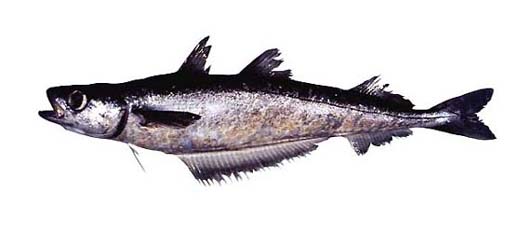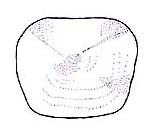タラ科
タラ科(Gadidae)

30 パタゴニアミナミダラ(Patagonia-minamidara)
Micromesistius australis australis Norman, 1937
Southern blue whiting (En.); Polaca (Arg.); Pescada de tres aletas (Ch.)
ミナミダラ(業界名)
特 徴:
第1背鰭11~13軟条,第2背鰭10~15軟条,第3背鰭22~27軟条,第1臀鰭33~41軟条,第2臀鰭23~30軟条,胸鰭20~23軟条,腹鰭6軟条,鰓耙数6~9+31~38=38~47,脊椎骨数24~26+30~32=54~57。体長に対する頭長の割合は19.1~25.6%,吻長は6.9~8.1%,眼径は5.2~6.7%,両眼間隔は4.4~6.0%,上顎長は9.1~10.3%。体は細長く,側扁する。口は大きく,上顎後端は眼の前縁下をやや越える。下顎先端に髭がない。上顎には非常に細かい絨毛状歯がありその外側に小さな円錐歯がまばらに分布する。下顎にも小さな円錐歯がまばらにある。鋤骨に絨毛状歯と円錐歯がある。鱗は円鱗できわめて脱落し易い。頭部も被鱗する。背鰭は3基で,いずれもその基底は短い。臀鰭は2基で,その基底は長い。体の背側は濃褐色,体側および腹側は銀白色,背鰭は褐色,胸鰭および尾鰭は濃褐色,臀鰭および腹鰭は銀白色。
分 布:
本種はアルゼンチンおよびチリのパタゴニア海域,ニュージーランド南方のキャンベルプラトウに分布する。近年,スコシア海のサウスジョージア,サウスシェトランドおよびサウスオークニーの各諸島にも分布することが明らかになった(Subnikov Permitin and Vonzjak., 1969; Kock, 1975)。パタゴニア沖の亜種は水深50mから900mに分布し,特に南緯50度以南の水深100mから600mにかけて多い。
備 考:
本種は2亜種に分類され,南米の亜種は体長に対する頭長の割合などのいくつかの体部比で,ニュージーランドの亜種(Micromesistius australis pallidus)と区別される(Inada and Nakamura, 1975)。本種は冬から初春にかけ,フォークランド諸島の南および東側で産卵する。産卵群は大きな濃密群を形成する。すり身原料としての商品価値がある。
(稲田伊史)
Material examined:
54 from Argentina (180.3-466.1 mm SL, 95-598 m depth), catalogue number: see Inada and Nakamura (1975).
Description:
D 11-13, 10-15, 22-27; A 33-41, 23-30; P1 20-23; P2 6; GR 6-9+31-38=38-47; BR 7; Ⅴ 24-26+30-32=54-57. HL 19.1-25.6 % of SL; SN 6.9-8.1; ED 5.2-6.7; IO 4.4-6.0; UJ 9.1-10.3; CP 3.9-6.3; P1L 14.2-19.3; P2L 8.6-14.0 (male); P2L 6.9-9.3 (female); PreD 31.8-36.1; PreA 31.2-37.2; PreP1 22.5-26.8; PreP2 20.8-27.0.
Body elongate, somewhat compressed, highest at level of anus. Head moderate, slightly more than 1/4 length of body; cephalic sensory pores obvious, about 11 or 12 in preoperculo-mandibular canal, about 8 in infraorbital canal, 2 in nasal component of supraorbital canal, about 4 in post-temporal component of cephalic lateralis and 1 in supraorbital commissure. Interorbital flat and somewhat narrow, its width about 0.9 times in diameter of eye. Eye rather large in size, about 0.6 times in length of upper jaw. No barbel on tip of lower jaw. Teeth on upper jaw biserial, inner row finely villiform and numerous, outer row depressible inward, slightly larger and sparse; teeth on lower jaw uniserial, long, sparse and depressible inward; a few depressible small teeth on vomer; no teeth on palatine. Scales cycloid, thin, small, and deciduous.
Distribution:
This species is distributed in the waters off Argentine and Chilean Patagonia and the Campbell Plateau, south of New Zealand. It was also found from the Scotia Sea, around South Georgia, South Shetland, and South Orkney Islands (Subnikov et al., 1969; Kock, 1975). The South American subspecies is distributed in depths of 50 m to 900 m, being especially abundant in 100 m to 600 m south of 50°S.
Remarks:
This species is divided into two subspecies, the Patagonian subspecies differing from the New Zealand subspecies, M. australis pallidus, on proportional lengths of the head, snout, upper jaw, eye diameter, and first dorsal fin base (Inada and Nakamura, 1975). M. a. australis forms large and dense spawning schools in the waters of south and east of the Falkland Islands during winter and early spring. It is utilized in Japan as surimi (minced meat) for kamaboko (fish cake).
(Tadashi INADA)

Distribution of Micromesistius australis australis in Patagonia.

Scale below mid lateral line.
- 1
- 2